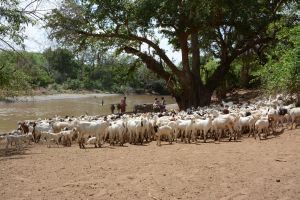Agriculture and forestry, including changes of land use, have a share of up to 30% in the emission of climate-damaging greenhouse gases worldwide. According to data of the German Environment Agency, agriculture was responsible for 6.7% of the 2013 greenhouse gas emissions in Germany. Researchers, including Professor Klaus Butterbach-Bahl of Karlsruhe Institute of Technology (KIT), therefore studied possibilities of mitigating greenhouse gas emissions from livestock farming by e.g. technical and organizational measures, intensification of livestock farming, and reduction of the demand for animal products. The findings are reported in the journal Nature Climate Change.
Worldwide, livestock farming is a big and dynamically growing sector: About 20 billion animals need about 30% of the land surface for grazing and one third of the farmland is used for the cultivation of fodder plants, according to the Food and Agriculture Organization of the United Nations FAO. Livestock farming reaches a share of up to 50% in the agricultural gross domestic product worldwide. In the past 40 years, per capita consumption of animal products more than doubled globally. Production has increased accordingly, with intensification and extension of agriculturally used surfaces playing important roles. “If these developments continue, severe impacts on the environment have to be expected, such as advancing deforestation and a significant increase in greenhouse gas emissions as well as a decrease of biological diversity,” Professor Klaus Butterbach-Bahl, Head of the Bio-Geo-Chemical Processes Division of the Institute of Meteorology and Climate Research – Atmospheric Environmental Research (IMK-IFU) of KIT, says. He is one of the authors of the paper published in Nature Climate Change.
The researchers estimate that worldwide livestock farming between 1995 and 2005 was responsible for annual greenhouse gas emissions of 5.6 – 7.5 gigatons of CO2 equivalents. CO2 equivalents give the greenhouse potential of a substance or activity. As a reference, carbon dioxide (CO2) is used, the most significant greenhouse gas. Among major emissions from livestock farming are methane (CH4) produced by fermentation when ruminants digest and nitrous oxide (N2O) from fodder production and use of land for fodder cultivation or as pastures. According to the German Environment Agency, about 54% of total methane emissions and more than 77% of the nitrous oxide emissions in Germany were produced by agriculture in 2013. “To understand how emissions from livestock farming develop and can be reduced in the future, we have to consider options on both the supply and the demand side,” Butterbach-Bahl adds. The researchers, hence, studied the emission reduction potential of technical and organizational measures in agriculture, intensification of livestock farming, and reduction of the demand for animal products. The paper published now is based on a study of earlier literature by Klaus Butterbach-Bahl and an evaluation of the methods to mitigate greenhouse gas emissions from livestock farming. During his research stay at the International Livestock Research Institute (ILRI) in Nairobi / Kenya, he established an environmental laboratory for the quantification of greenhouse gas footprints of livestock farming systems in Africa.
One finding of the scientists: Measures, such as fodder additives, easier to digest animal feed, a more efficient use of farm manure, and carbon binding in soils of grass landscapes by sustainable grazing can reduce greenhouse gas emissions by 0.01 to 0.5 gigatons CO2 equivalents per year. Increasing productivity of animals, farmland, and pastures can directly reduce greenhouse gas emissions and have additional indirect positive impacts, as it helps reduce agricultural areas and prevent deforestation.
Lower demand for meat and milk will also contribute considerably to reducing greenhouse gas emissions. Production of beef protein, for instance, needs 50 times as much land and causes 100 times as much greenhouse gas emission than the production of vegetable protein on the average. Demand can be reduced, for instance, by changing prices in favor of food products, the production of which is associated with low emissions or by a deliberate change of nutrition in view of the environmental pollutions frequently resulting from animal production.
In total, measures in livestock farming might reduce greenhouse gas emissions from agriculture, forestry, and land use by up to 50%, in the opinion of the researchers. As regards measures on the supply side, the scientists see a high potential from the technical perspective, but admit that only about 10% of this potential might be reached under economically acceptable conditions. The reasons are use limitations, costs, and opposite dependencies. Measures on the demand side are of high potential that still cannot be quantified from the economic perspective. “To enhance applicability and affordability of technical and organizational measures and prevent negative impacts on the basis of life, economic activities, and the environment, further research and development work is urgently required,” Klaus Butterbach-Bahl says.
Mario Herrero, Benjamin Henderson, Petr Havlík, Philip K. Thornton, Richard T. Conant, Pete Smith, Stefan Wirsenius, Alexander N. Hristov, Pierre Gerber, Margaret Gill, Klaus Butterbach-Bahl, Hugo Valin, Tara Garnett, and Elke Stehfest: Greenhouse gas mitigation potentials in the livestock sector. Nature Climate Change, published online 21 March 2016. DOI: 10.1038/nclimate2925.
More about the KIT Climate and Environment Center: http://www.klima-umwelt.kit.edu/english
Being “The University in the Helmholtz Association”, KIT creates and imparts knowledge for the society and the environment. It is the objective to make significant contributions to the global challenges in the fields of energy, mobility, and information. For this, about 10,000 employees cooperate in a broad range of disciplines in natural sciences, engineering sciences, economics, and the humanities and social sciences. KIT prepares its 22,800 students for responsible tasks in society, industry, and science by offering research-based study programs. Innovation efforts at KIT build a bridge between important scientific findings and their application for the benefit of society, economic prosperity, and the preservation of our natural basis of life. KIT is one of the German universities of excellence.

